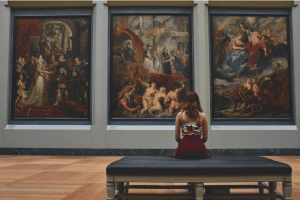Nigel Glenday, CFO of Masterworks, highlights the potential of art as a recession-proof investment, driven by its scarcity, global demand, and ability to preserve and grow wealth, while Masterworks democratizes art investments, making high-priced art accessible to all.

At the intersection of aesthetics and economics, art has emerged as a compelling avenue for investment. Nigel Glenday, the CFO of the Masterworks investing platform, is a firm believer in the potential of art as a high-performance asset class. Shaped by his background in banking, Glenday’s perspective allows him to view the art world through the lens of corporate finance.
This fusion of finance and art is a testament to the evolving dynamics of the investment landscape. In a recent interview, Glenday shared his insights on the art market and its potential as a recession-proof investment.
“You’ve got an asset that has relative scarcity,” he explained. “If you’re talking about an artist that’s passed away, that supply is fixed and on the other side of that you have a wave of demand that’s coming from high net worth individuals.” This scarcity, coupled with increasing global demand, makes art an especially effective and resilient store of wealth.
Understanding art as an investment
The global art market is a fascinating ecosystem, teeming with a diverse array of artworks that span different periods, styles, and cultures. Its reach is truly global, transcending geographical boundaries and connecting art enthusiasts from all corners of the world.
Over the years, this market has developed a robust infrastructure, with art fairs, galleries, and auctions serving as vibrant platforms for the exchange of valuable artworks.
“Art is a global asset. You can buy your painting in New York, then fly to Hong Kong and sell it there. You can sell it in London. You can even sell it across currencies. This creates a natural mitigation to macroeconomic pressures in any one region,” said Glenday.
Furthermore, the allure of art extends beyond its cultural and aesthetic appeal. Art, particularly paintings, has proven to be a reliable store of value. Historical trends show a consistent pattern of capital appreciation, making art an attractive investment proposition to those looking to diversify their portfolios.
This financial potential of art is often overlooked, overshadowed by its intrinsic artistic value. However, as Glenday points out, art’s ability to preserve and grow wealth is a facet that deserves recognition.
Masterworks and democratizing art investments
Masterworks is leading a significant shift in the art world. The company is democratizing art investment, breaking down the barriers that have traditionally made high-priced art the exclusive domain of the extremely wealthy. By creating securities out of individual paintings, Masterworks is making it possible for anyone to own a share in a masterpiece.
In the words of Nigel Glenday, “What’s important to understand about Masterworks, we’re an asset class-centric business. So what that means is we have core conviction in the asset class and it’s our mission then to find the different products and channels that make that asset class investable.”
This mission has led to the creation of a platform that allows investors to select individual offerings that meet their risk-return tolerance and build their own portfolios.
Moreover, the Masterworks collection is a testament to the company’s commitment to quality. Each painting is selected through a rigorous, data-driven process. The focus is on acquiring works from artists who have a proven track record in the art market. This ensures that investors have access to pieces that are not only aesthetically pleasing but also have a strong potential for appreciation.
Art investments as a recession-proof asset
Art investments possess a unique resilience that distinguishes them from many other asset classes, particularly during periods of inflation and economic upheaval. Glenday highlights historical data that demonstrates the strong performance of art during periods of high inflation.
For example, fine art prices saw an appreciation of approximately 17.5% during such times, outperforming the S&P 500 and other traditionally safe assets.
“Art has performed incredibly well during recessions,” Glenday said. “What you’re seeing in those indices is not only the valuation of art during that period but how it’s really driven by the supply of art that’s available.”.
The ability of art investments to weather economic downturns is a key factor in Glenday’s conviction in the potential of art as an investment. Art is a tangible asset, and its value is not tied to corporate earnings or interest rates but is driven by its cultural significance, rarity, and aesthetic appeal.
Final thoughts
Investing in art is not just about financial returns. It’s about being part of a global community of art enthusiasts. It’s about supporting artists and contributing to the vibrancy of the art market. And, as Masterworks is showing, it’s an opportunity that is becoming increasingly accessible to all.
As we navigate through uncertain economic times, the wisdom in Glenday’s words becomes even more apparent. Art is an asset class that has stood the test of time, preserving wealth through economic cycles and offering a sanctuary during financial storms.
As Glenday and the team at Masterworks continue to democratize access to the art market, we can expect to see more investors turning to art as a way to diversify their portfolios, protect their wealth, and engage with the rich and diverse world of art.
The subject matter and the content of this article are solely the views of the author. FinanceFeeds does not bear any legal responsibility for the content of this article and they do not reflect the viewpoint of FinanceFeeds or its editorial staff.






